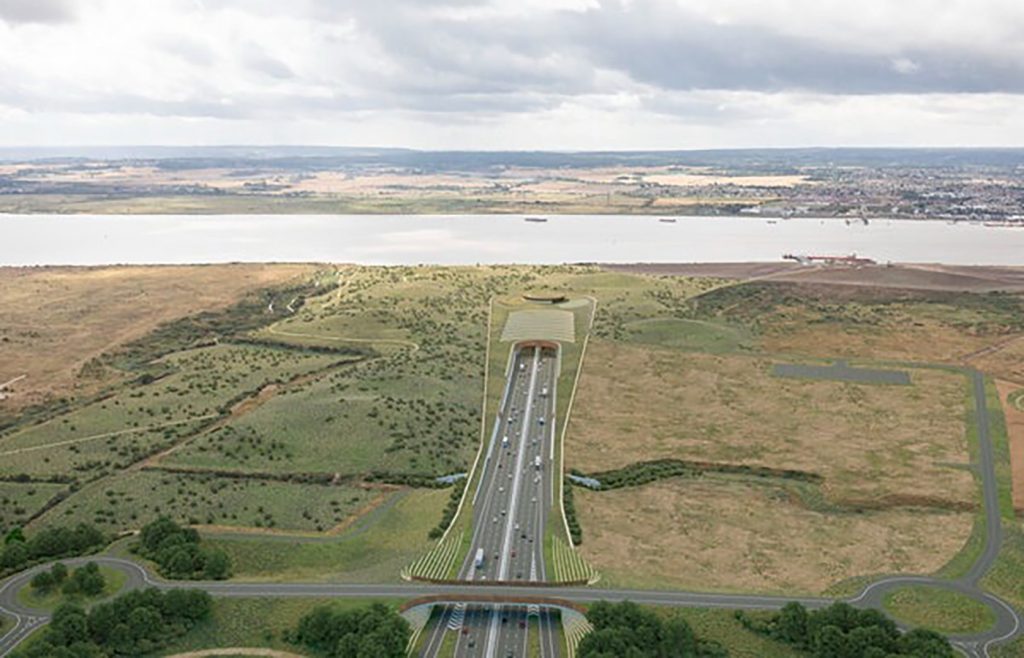
A new forecast released by National Highways today (18 July 2022) shows that the government’s plans to decarbonise cars and goods vehicles would cut the 60-year forecast of carbon emissions from Lower Thames Crossing traffic by at least 80%.
The Lower Thames Crossing is designed to improve journeys for tens of thousands of people who get caught in congestion daily at the Dartford Crossing and nearby roads. The Dartford Crossing is one of the UK’s most vital links, connecting key ports, distribution hubs and manufacturing centres, but it is also one of the most unreliable roads as the huge volumes of traffic regularly leads to long delays and frustration. The Lower Thames Crossing would almost double road capacity across the Thames east of London, improving journeys across the region and creating a reliable new connection that will boost the economy. It would also reduce traffic on the Dartford Crossing by over 13million vehicles per year, reducing congestion and improving air quality in the area.
The reduction in road carbon emissions is thanks to the ambitions stated in the government’s Decarbonising Transport Plan, released one year ago, that would see the sale of new petrol and diesel cars and vans end in 2030, around the same time the Lower Thames Crossing is scheduled to open. Within ten years of the crossing opening, the vast majority of cars are expected to be electric plug-in vehicles and all UK roads, including the Lower Thames Crossing, are included in the UK’s commitment to reach net zero carbon by 2050.
As the design of the Lower Thames Crossing has developed, the carbon estimates from traffic have been calculated based on the latest design of the new road and forecasted proportions of petrol, diesel, electric and other vehicles. When the preferred route of the crossing was assessed in 2016, the initial carbon estimate was 5.98 million tonnes.
The latest estimate based on the current design and traffic forecasts shows this has fallen to 4.6 million tonnes. National Highways has also undertaken an additional assessment to reflect the expected uptake of electric and other zero tailpipe emissions vehicles shown in the Decarbonising Transport Plan. This assessment sees the forecast fall to less than a million tonnes – a reduction of at least 80% compared to the project’s initial 2016 baseline.
The take up of low emissions vehicles in the UK is accelerating as consumer choice and access to charging infrastructure improves. The government’s Net Zero Strategy pathway, which set out how the UK will deliver on its commitment to reach net zero emissions by 2050, assumed that 24% of all cars on the road would be zero emission by 2030, and 53% by 2035. The latest figures released by the Society of Motor Manufacturers and Traders show that the UK is making rapid progress, with 50% of new cars registered in the UK in June were electric or hybrid.
Matt Palmer, Executive Director for the Lower Thames Crossing said: “Our Strategic Roads play a critical role in keeping the country moving, now and in a net zero UK. Today’s announcement demonstrates that planned government policies would dramatically reduce carbon by accelerating the shift away from petrol and diesel vehicles.
“The modelling released today shows that if those policies are successful, the cars and trucks that will use the Lower Thames Crossing will have lower or zero tailpipe emissions, removing pollution and supporting our country’s movement to net zero.
“This is great news, however on Lower Thames Crossing we know we need to go further, so we are also focusing our efforts to push the boundaries on cutting carbon in construction and creating a legacy of local green skills. We want to make this the greenest road in the UK, built for a net zero fleet of vehicles.”

Shevaun Haviland, Director General of British Chambers of Commerce, said: “The Dartford Crossing is one of our most vital trade routes, but also one of our most unreliable. The addition of the new Lower Thames Crossing is needed now more than ever, and will connect people to jobs, businesses to new markets, and leave a legacy of green skills across the region. This significant infrastructure improvement project will have a hugely positive impact by enabling the growth of businesses right across the region.”
In February this year, National Highways designated the Lower Thames Crossing a pathfinder scheme that will explore ways of being carbon neutral during construction, and it became the first major infrastructure project to use its procurement process to lock its carbon ambitions into agreements with major contractors. It has already significantly reduced predicted emissions during construction by carefully designing the route and structures, using only renewable energy sources, reusing waste, and using low-carbon materials. The project is now looking at hydrogen and electric construction vehicles and using alternatives to carbon-intensive construction materials.
The project is seeking to be the greenest road ever built in the UK, with its ambitious carbon reduction targets matched by plans to enhance biodiversity, build two new public parks and a community woodland, and promote active travel with almost 40 miles of new or improved pathways for walkers, cyclists and horse riders. The scheme includes the longest road tunnel in the UK to protect the Thames and nearby wetlands and seven green bridges that will provide safe crossing points for people and wildlife.
National Highways has recently held a consultation on some local refinements to the Lower Thames Crossing before it submits an application for a Development Consent Order later this year.
The Lower Thames Crossing’s revised carbon forecasts are published here – https://nationalhighways.co.uk/our-roads/lower-thames-crossing/environment





